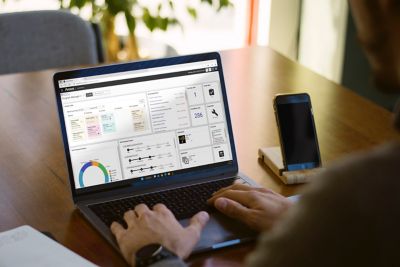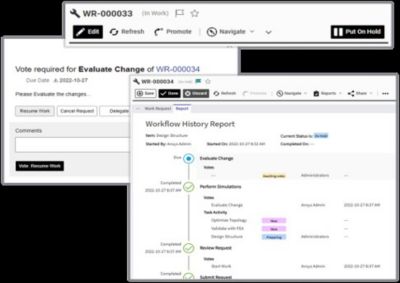-
Ansys si impegna a fare in modo che gli studenti di oggi abbiano successo, fornendogli il software gratuito di simulazione ingegneristica.
-
Ansys si impegna a fare in modo che gli studenti di oggi abbiano successo, fornendogli il software gratuito di simulazione ingegneristica.
-
Ansys si impegna a fare in modo che gli studenti di oggi abbiano successo, fornendogli il software gratuito di simulazione ingegneristica.
-
Contattaci -
Opportunità di lavoro -
Studenti e Accademici -
Per Stati Uniti e Canada
+1 844.462.6797
ANSYS BLOG
October 13, 2023
Ride the Digital Wave: Let SPDM Relieve Data Overflow
With digital transformation affecting nearly every industry, from automotive and aerospace to consumer electronics and healthcare, organizations are adopting more tools and technologies than ever before. However, while it’s beneficial to embrace new workflows, disparate technologies and disconnected solutions scattered across departments can slow down production and result in organizational silos. Compounding the problem, each tool set holds its own set of data. This not only creates an information overload, but also adds more disconnection and workflow interruption, requiring team members to locate and find data from other teams or previous projects.
How can organizations ride the digital wave and relieve this data overflow? Simulation process and data management (SPDM) software offers one of the easiest-to-implement solutions. SPDM enables teams to manage simulation, data, workflows, and resources throughout their organization, spanning various departments and engineering disciplines, from one central database. This means that by implementing an SPDM solution such as Ansys Minerva, companies can create a digital thread throughout all stages of the product life cycle, increasing productivity, design success, and collaboration.

Simulation process and data management (SPDM) software, such as Ansys Minerva, enables teams to manage simulation, data, workflows, and resources throughout their organization from one central database.
Overcome Data Overwhelm with SPDM
SPDM overcomes some of the biggest challenges and pain points of modern-day workflows. As mentioned, disconnected solutions are a common plight of the digital age, given the abundance of tools and technologies used across organizations. Added to this, most companies consist of multidisciplinary teams, making workflows even more complex. SPDM combats these challenges by amalgamating dozens — sometimes hundreds — of tools into one shared database, allowing multiple users to view and use shared files and define work requests.
As a leading SPDM software, Minerva provides all of this and more, including management and decision support in both on-premises and cloud deployment ecosystems. This makes it even easier to connect team members regardless of location, department, or other workspace limitations.

In Minerva, managers and team members can retrieve the status of works in progress, metrics, and more, which prevents production delays due to employee absence or organizational changes.
Further, Minerva can configure, launch, and manage data flow from any common local application, enabling team members to use the programs and workflows they’re most comfortable with while still collaborating effectively with others. In this way, SPDM helps democratize simulation, making it more accessible and user-friendly.
Similarly, with configurable, role-based dashboards in Minerva, managers and team members can retrieve the status of works in progress, key metrics, assignments, and much more — despite who’s in the office or whether a team member is not a simulation expert. This prevents production delays due to employee absence or organizational changes that may disrupt workflows, such as departmental shifts.
Create a Digital Thread with SPDM
What exactly is a digital thread and how can it help your organization? Simply put, a digital thread is a connection of digital solutions. But more than this, it creates a line of connectivity among people, tools, and projects. For simulation workflows, this seamless digital thread is actually an inherent component of an SPDM solution. In other words, an organization may implement an SPDM solution simply to organize its simulation workflows, but SPDM intrinsically creates a digital thread of the tools and applications within these workflows in the process. This is advantageous for any organization, regardless of industry.
A digital thread of simulation solutions helps companies increase traceability throughout the full product life cycle. This means you can track a product and its digital assets from early-stage conception through late-stage design and development. Designers can easily share models with mechanical engineers or other experts outside of their department, and vice versa. But the implementation of a digital thread isn’t just about improving product design or accelerating development. It also improves design and development culture, fostering a more inclusive work environment. For example, Minerva offers automatic data extraction and built-in messaging, which ensures traceability and encourages collaboration, respectively.
With a vendor-neutral architecture, Minerva blends easily into existing workflows, providing seamless integration. Acting as a one-stop simulation shop, Minerva offers native interoperability with popular computer-aided design (CAD) and computer-aided engineering (CAE) tools, as well as product life cycle management (PLM) systems. Minerva also integrates easily with other Ansys Connect family products, including Ansys Granta MI Enterprise materials management, Ansys optiSLang process integration and design optimization, and Ansys ModelCenter model-based systems engineering (MBSE) software.

SPDM assists with operational efficiency, productivity, and digital transformation.
Keep Things Simple with SPDM
Rapid advancements in technology worldwide are requiring companies to embrace digital transformation and adapt to modernized workflows. With this, more companies are leveraging the pervasive insights of simulation and generating more data. An effective SPDM solution can optimize operational efficiency, enhance productivity, and enable a much faster and smoother adoption of digital transformation.
To learn more about Minerva and how an SPDM solution can benefit your team, explore the Ansys Minerva Webinar Series and register for on-demand access today.
Scopri cosa Ansys può fare per te
Scopri cosa Ansys può fare per te
Contattaci subito
Grazie per averci contattato!
Siamo qui per rispondere alle tue domande e non vediamo l'ora di parlare con te. Un membro del nostro team di vendita Ansys ti contatterà a breve.











